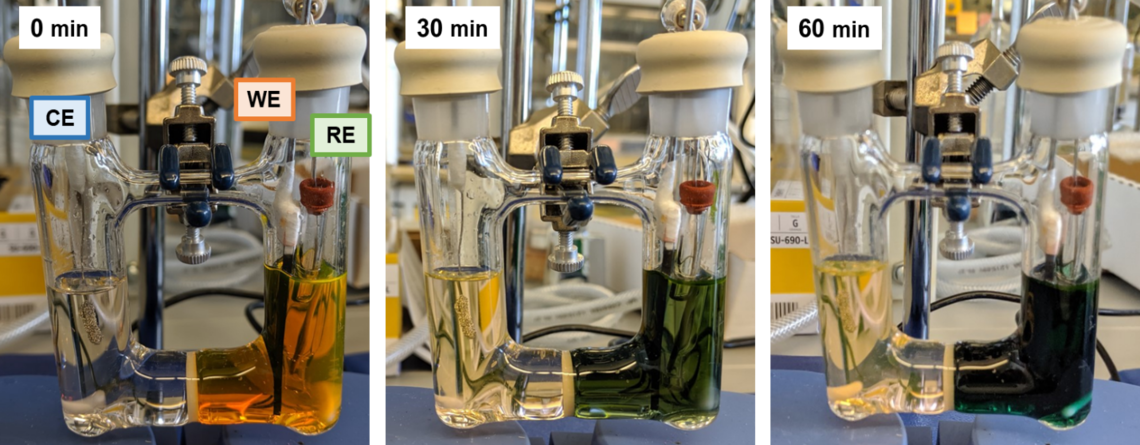Oct. 27, 2021
Student-led international project develops new chemical pathway to turn carbon dioxide into useful products

Joshua Koenig’s work in catalyst design focuses on “closing the carbon loop.” It involves converting carbon dioxide (CO2) into useful fuels and chemical feedstocks, keeping the greenhouse gas out of atmosphere.
“Closing the carbon loop using CO2 conversion processes powered by renewable energy sources could be a powerful way to combat global warming caused by greenhouse gas emissions,” says Koenig, a PhD student in the Department of Chemistry in the Faculty of Science.
However, because of CO2’s properties, chemically activating the inert gas requires a lot of energy — even when using catalysts to help convert the CO2.
Now, in an international, doctoral student-led research project, Koenig was able to chemically modify a well-known organometallic catalyst so it efficiently converts CO2 into carbon monoxide using much less energy. Carbon monoxide is a chemical feedstock that can be used to make synthetic fuel and a variety of chemicals.
Koenig modified the organometallic catalyst (called rhenium bipyridine) by linking it to an “organic chromophore” commonly found in red paints (a chromophore is the part of a molecule responsible for its colour).
“I synthesized a new organometallic-chromophore dyad, which performed the same chemical transformation that the standard organometallic catalyst does on its own, but at a much lower applied voltage," Koenig says. “Our finding represents an exciting new avenue for exploring improved catalyst design.”

Joshua Koenig. left, and Zachary Dubrawski.
“The discovery Josh made is beautiful chemistry,” says project collaborator Zachary Dubrawski, also a PhD student in the Department of Chemistry. “It opens a new door in the molecular design field.”
Dubrawski analyzed the catalytic reaction that used Koenig’s modified catalyst, to determine what each of the chemical steps in the catalytic cycle looked like.
Koenig also reached out to Keerthan Rao, a PhD student in chemistry at the University of Kentucky, to construct a computational model of the catalytic reaction. This model corroborated Koenig’s experimental observations and Dubrawski’s mechanistic analysis.
“Overall, this project harmoniously blended the unique expertise of three different research groups successfully into one high-impact collaboration,” Koenig says.
Koenig is the lead author on the team’s paper, “Lowing Electrocatalytic CO2 Reduction Overpotential Using N-Annulated Perylene Diimide Rhenium Bipyridine Dyads with Variable Tether Length,” which is published in the Journal of the American Chemical Society.
Project required entrepreneurial approach
The project’s success required a lot of persistence, the strength of collaboration, and some entrepreneurial thinking.
Koenig, a member of the research group led by professor of organic chemistry Dr. Gregory Welch, PhD, made his key discovery of the modified CO2 conversion catalyst just prior to the start of the COVID-19 pandemic. The pandemic shut down the Welch lab for three months.
“So I’m sitting with this great result and there’s absolutely nothing I can do with it now,” Koenig says.
That’s when he reached out to one of Welch’s chemistry colleagues, Dr. Chad Risko, PhD, at the University of Kentucky. Risko connected one of his PhD students, Keerthan Rao, with Koenig.
Koenig also enlisted Dubrawski, a member of the research group led by chemistry professor Dr. Warren Piers, PhD, in the project.
The collaboration combined the Welch group’s expertise in pi-conjugated materials for organic electronics with the Piers group’s knowledge of organometallic complexes commonly used as catalysts.

Koenig's electrochemistry setup, showing the change in colour over time.
Courtesy Josh Koenig
Adding Rao’s computational modelling expertise “yielded a much more robust result,” Dubrawski says.
“We were able to successfully design a series of dyad systems, fully investigate their optoelectronic properties, and test their CO2 conversion abilities,” Koenig says.
The team showed that the chromophore added to the organometallic catalyst acted as an “electron reservoir” for the catalyst, thus enabling a new and highly effective catalytic CO2 conversation pathway.
“This was a student-led interdisciplinary project that tackled aspects of climate change, and has now been recognized by one of the top journals in science,” says Welch.
“One of the top goals of our team supported by Canada First Research Excellence Fund was to discover new catalyst design principles for efficient CO2 conversion,” says Piers. “Josh has delivered on that promise with a key insight that will inform innovation in this area for years to come.”
The “real-world” significance of the research is that there are hundreds of already-known CO2 conversion catalysts and organic chromophores, but most operate with high energy demands. The work done by Koenig and colleagues provides a straightforward way to inexpensively reduce the input energy required.
With further work, it’s possible to develop some organometallic-chromophore dyad combination that would deliver “champion” CO2 conversion performance at an industrial scale, Koenig says.
The team’s research was funded by the Natural Sciences and Engineering Research Council of Canada, the Canada First Research Excellence Fund, and the Canada Foundation for Innovation.






